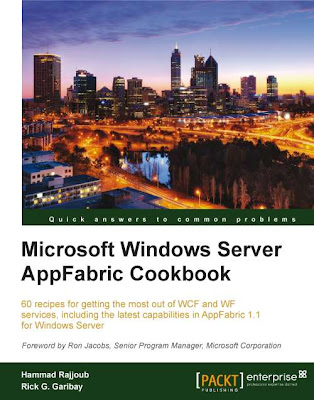Book Detail
Paperback: 428 pages
Publisher: Packt Publishing (July 26, 2012)
Language: English
ISBN-10: 1849684189
ISBN-13: 978-1849684187
File Size : 31.4 Mb | File Format : PDF + Epub
Book Description From Book Cover :
Windows Server AppFabric is an extension of the Application Server Role on the Windows Server Platform. In a nutshell, Windows Server AppFabric frees Windows Communication Foundation (WCF) and Windows Workflow Foundation (WF) Service developers from common infrastructure plumbing by providing a robust, secure, composable, and reliable platform which provides caching, hosting, and monitoring capabilities, including support for long running workflow services, all on the Windows Platform. As such, Windows Server AppFabric is an evolution of the Windows Server platform, providing essential building blocks for first- classing WCF (for code-based services) and WF (for declarative workflow services) that are built using the .NET Framework 4 and Visual Studio 2010.
As an extension to IIS and WAS, Windows Server AppFabric relies on IIS's proven capabilities for hosting and lifecycle management, adding additional useful capabilities for working with WCF and WF services. In addition, Windows Server AppFabric takes advantage of Windows Server's robust event tracing mechanism (also known as ETW). ETW provides optimized and high-performing kernel-level instrumentation which greatly minimizes impact on the performance of WCF and WF services hosted in IIS with Windows Server AppFabric.
Whether you are a developer who wants to avoid the same repetitive tasks when preparing your WCF and/or WF services for deployment, or an IT Pro who wants to avoid complex XML for configuring hosting and monitoring options for the services you manage, you will instantly benefit from Windows Server AppFabric. Best of all, Microsoft has made this key extension to the Windows Server Platform available free of charge.
Written by both a former MVP and now Architect Evangelist with Microsoft and a five-time Connected Systems Developer MVP, the authors of this book both worked very closely with Microsoft during the development of the product (then codenamed "Dublin") participating in Software Design Reviews and early incubation initiatives. Hammad and Rick have advised customers of all shapes and sizes and fielded these capabilities in countless projects across various verticals in the two years since its general availability.
This book is full of practical, step-by-step guidance including useful tips and techniques that will allow you to build scalable, reliable, and secure service-oriented applications on the Windows Server Platform with IIS and Windows Server AppFabric.
Table of Contents
Chapter 1: Installing Windows Server AppFabric
Introduction
Installing Windows Server AppFabric
Configuring Windows Server AppFabric (hosting and monitoring)
Configuring Windows Server AppFabric (caching)
Installing Cache Client Assemblies
Changing the Windows Server AppFabric configuration after installation
Starting a Caching service
Troubleshooting Windows Server AppFabric – configuration errors
Troubleshooting Windows Server AppFabric – auto restart issues
Chapter 2: Getting Started with AppFabric Caching
Introduction
Initializing Cache Client using code
Initializing Cache Client using configuration
Programming AppFabric Cache Client
Using AppFabric Cache via the ASP.NET provider model
Using AppFabric local cache
Using the AppFabric cache management tool
Building a custom provider model
Handling common Windows Server AppFabric caching errors
Chapter 3: Windows Server AppFabric Caching – Advanced Use Cases
Introduction
Using regions in cache
Using tags in cache
Using optimistic concurrency
Using pessimistic concurrency
Setting up expiration
Setting up eviction
Setting up notifications
Using performance counters
Troubleshooting throttling
Troubleshooting eviction
Setting up read through – write behind
Chapter 4: Windows Server AppFabric Hosting Fundamentals
Introduction
Installing the Web Deployment tool (Web Deploy)
Packaging services for deployment with Web Deploy
Hosting WCF services
Hosting WCF REST services
Hosting basic workflow services
Chapter 5: More Windows Server AppFabric Hosting Features
Introduction
Hosting long-running workflow services
Taking advantage of WAS and Auto-Start
Hosting Windows Azure Relay services
Using common Server AppFabric hosting commandlets
Chapter 6: Utilizing AppFabric Persistence
Introduction
Using Windows Server AppFabric workflow persistence
Programmatically querying persisted workflow instances
Programmatically controlling persisted workflow instances
Developing an Instance Store provider
Developing an Instance Query provider
Developing an Instance Control provider
Registering and configuring custom store, query, and control providers
Chapter 7: Monitoring Windows Server AppFabric Deployment
Introduction
Collecting events from WCF and WF services
Viewing and classifying events in the AppFabric Dashboard
Enabling tracing and evaluating trace logs with WCF
Creating a customized tracking profile for WF services
Accessing the Monitoring DB
Building a custom dashboard
Using monitoring database cmdlets
Monitoring cache cluster health
Chapter 8: Scaling AppFabric Hosting, Monitoring, and Persistence
Introduction
Creating an initial base configuration
Adding and removing servers from the farm
Application deployment on the farm
Configuration and management on the farm
Automating deployment with scripts
Chapter 9: Configuring Windows Server AppFabric Security
Introduction
Running caching services using Domain accounts
Setting up security for persistence stores
Securing Windows Server AppFabric's monitoring store
Securing the Event Collection service
Index
Download Ebook : Microsoft Windows Server AppFabric Cookbook
Depositfiles : Microsoft Windows Server AppFabric Cookbook


.jpg)






0 comments:
Post a Comment